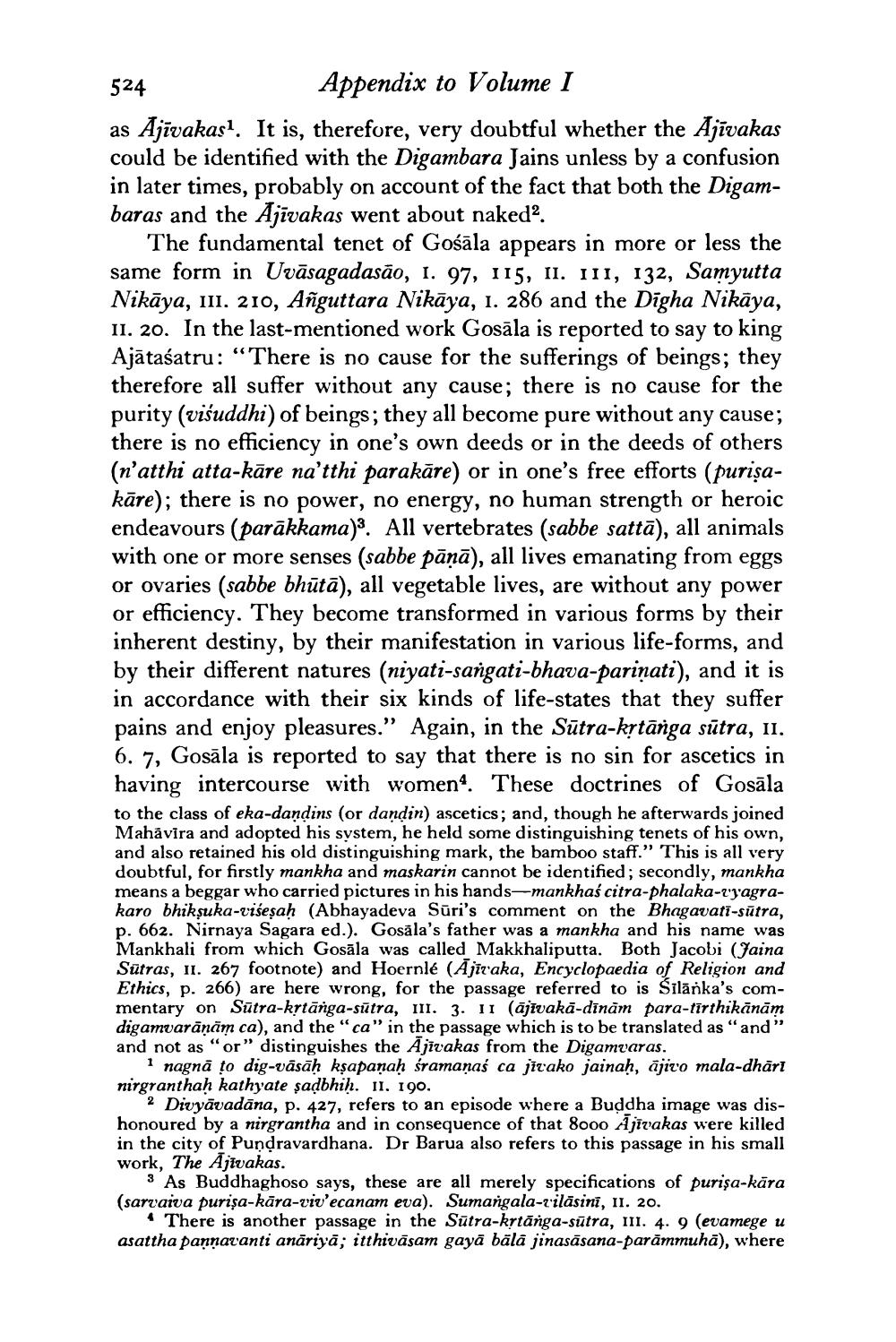________________
524
Appendix to Volume I as Ajīvakası. It is, therefore, very doubtful whether the Ajīvakas could be identified with the Digambara Jains unless by a confusion in later times, probably on account of the fact that both the Digambaras and th kas went about naked?.
The fundamental tenet of Gośāla appears in more or less the same form in Upāsagadasão, I. 97, I5, II, III, I32, Samyutta Nikāya, III. 210, Añguttara Nikāya, 1. 286 and the Digha Nikāya, 11. 20. In the last-mentioned work Gosāla is reported to say to king Ajātaśatru: “There is no cause for the sufferings of beings; they therefore all suffer without any cause; there is no cause for the purity (višuddhi) of beings; they all become pure without any cause; there is no efficiency in one's own deeds or in the deeds of others (n'atthi atta-kāre na'tthi parakāre) or in one's free efforts (purişakāre); there is no power, no energy, no human strength or heroic endeavours (parākkama). All vertebrates (sabbe sattā), all animals with one or more senses (sabbe pāņā), all lives emanating from eggs or ovaries (sabbe bhūtā), all vegetable lives, are without any power or efficiency. They become transformed in various forms by their inherent destiny, by their manifestation in various life-forms, and by their different natures (niyati-sangati-bhava-parinati), and it is in accordance with their six kinds of life-states that they suffer pains and enjoy pleasures." Again, in the Sūtra-kytānga sūtra, II. 6. 7, Gosāla is reported to say that there is no sin for ascetics in having intercourse with women. These doctrines of Gosāla to the class of eka-dandins (or dandin) ascetics; and, though he afterwards joined Mahavira and adopted his system, he held some distinguishing tenets of his own, and also retained his old distinguishing mark, the bamboo staff." This is all very doubtful, for firstly mankha and maskarin cannot be identified; secondly, mankha means a beggar who carried pictures in his hands-mankhaś citra-phalaka-z'yagrakaro bhikṣuka-višeşah (Abhayadeva Sūri's comment on the Bhagavatī-sūtra, p. 662. Nirnaya Sagara ed.). Gosāla's father was a mankha and his name was Mankhali from which Gosāla was called Makkhaliputta. Both Jacobi (Jaina Sūtras, II. 267 footnote) and Hoernlé (Ajiraka, Encyclopaedia of Religion and Ethics, p. 266) are here wrong, for the passage referred to is Sīlānka's commentary on Sūtra-kytānga-sútra, II. 3. 11 (ājīvakā-dīnām para-tīrthikānām digamvarāņām ca), and the “ca" in the passage which is to be translated as "and" and not as “or” distinguishes the Ājivakas from the Digamvaras.
nagnā to dig-vāsāh kşapanah sramanaś ca jitako jainah, ăjito mala-dhari nirgranthah kathyate sadbhiḥ. II. 190.
2 Divyāvadāna, p. 427, refers to an episode where a Buddha image was dishonoured by a nirgrantha and in consequence of that 8000 Ajīvakas were killed in the city of Pundravardhana. Dr Barua also refers to this passage in his small work, The Ajivakas.
3 As Buddhaghoso says, these are all merely specifications of purişa-kāra (sarvaiva purisa-kāra-viv'ecanam eva). Sumangala-vilasini, II. 20.
* There is another passage in the Sūtra-krtănga-sūtra, III. 4. 9 (evamege u asattha pannatanti anāriyā; itthivasam gayā bāla jinasāsana-parāmmuhā), where




